Introduction: Finland's Artistic Ambassador
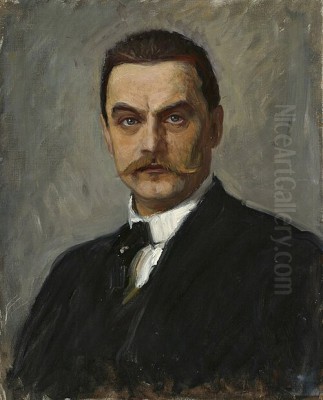
Albert Gustaf Aristides Edelfelt (1854–1905) stands as a monumental figure in the annals of Finnish art history. Emerging during a crucial period of national awakening, Edelfelt became one of the first Finnish artists to achieve widespread international fame. His work, deeply rooted in Realism and Naturalism, captured the essence of Finnish life, landscapes, and history, while also embracing the sophisticated techniques and cosmopolitan spirit he absorbed during his extensive time abroad, particularly in Paris. He was not merely a painter but a cultural ambassador who brought Finnish art onto the world stage, paving the way for the Golden Age of Finnish Art.
Noble Roots and Early Artistic Inclinations
Born on July 21, 1854, in Porvoo (Borgå), Finland, Albert Edelfelt hailed from a Swedish-speaking noble family that valued culture and education. His father, Carl Albert Edelfelt, was a respected architect, and his mother, Alexandra Edelfelt (née Brandt), was a woman of noble descent with talents in music and writing. This cultured environment undoubtedly nurtured young Albert's artistic sensibilities. Following his father's early death, his mother Alexandra played a pivotal role in supporting his aspirations, despite facing financial constraints while raising Albert and his younger siblings.
Edelfelt's formal artistic training began in Helsinki. He attended the Drawing School of the Finnish Art Society, laying the foundational skills for his future career. Concurrently, he pursued studies in languages and history at the Imperial Alexander University (now the University of Helsinki), broadening his intellectual horizons. His early promise was recognized, and he received private instruction from Bernhard Reinhold, a visiting German portrait painter, further honing his skills in capturing likeness and character.
Academic Foundations: Helsinki and Antwerp
In Helsinki, Edelfelt studied under Adolf von Becker, a Finnish painter who himself had trained internationally and brought academic rigor to his teaching. Von Becker's guidance provided Edelfelt with a solid grounding in traditional techniques. Seeking more advanced training, particularly in the prestigious genre of history painting, Edelfelt traveled to Belgium in 1873.
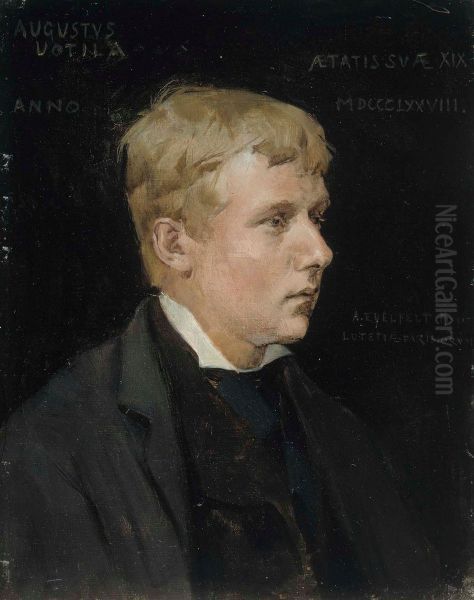
He enrolled at the Royal Academy of Fine Arts in Antwerp for the academic year 1873-1874. Antwerp, with its rich artistic heritage, particularly its connection to masters like Peter Paul Rubens, offered a different perspective on historical and figurative painting. This period, though relatively brief, was crucial in exposing Edelfelt to the broader European academic tradition beyond Finland and preparing him for the ultimate artistic crucible: Paris.
Paris: The Heart of the Art World
In 1874, Edelfelt moved to Paris, the undisputed capital of the 19th-century art world. This move would prove decisive for his career and artistic development. He gained admission to the prestigious École nationale des beaux-arts, the epicenter of French academic art. There, he entered the studio of Jean-Léon Gérôme, a highly influential painter known for his meticulous historical and Orientalist scenes.
Studying under Gérôme instilled in Edelfelt a profound respect for draftsmanship, anatomical accuracy, and carefully constructed compositions. Gérôme's emphasis on historical detail and polished finish is visible in Edelfelt's early historical paintings. However, Paris offered more than just academic training; it was a vibrant hub of artistic innovation, debate, and camaraderie.
Embracing Realism and Naturalism
While respecting his academic training, Edelfelt was keenly aware of the newer artistic currents swirling through Paris. He became increasingly drawn to Realism and, particularly, to Naturalism, championed by artists like Jules Bastien-Lepage. This movement advocated for depicting contemporary life and landscapes with objective truthfulness, often incorporating the effects of natural light observed outdoors (en plein air).
Edelfelt began to shift away from purely historical subjects towards scenes of everyday life, portraits, and landscapes rendered with a greater sensitivity to light, atmosphere, and psychological nuance. He adopted a brighter palette and looser brushwork compared to strict academic standards, skillfully blending Gérôme's precision with the immediacy and light-filled qualities of Naturalism and, to some extent, Impressionism. He became a master at capturing fleeting moments and the subtle play of light on surfaces.
Life and Connections in the Parisian Art Scene
Edelfelt quickly integrated into the cosmopolitan art community in Paris. For a time, he shared a studio with the American painter Julian Alden Weir. It was Weir who introduced Edelfelt to another prominent American expatriate artist, John Singer Sargent. Edelfelt developed friendships and professional relationships with numerous artists, including French painters like Pascal Dagnan-Bouveret and Henri Gervex. These interactions provided intellectual stimulation and kept him abreast of the latest artistic developments.
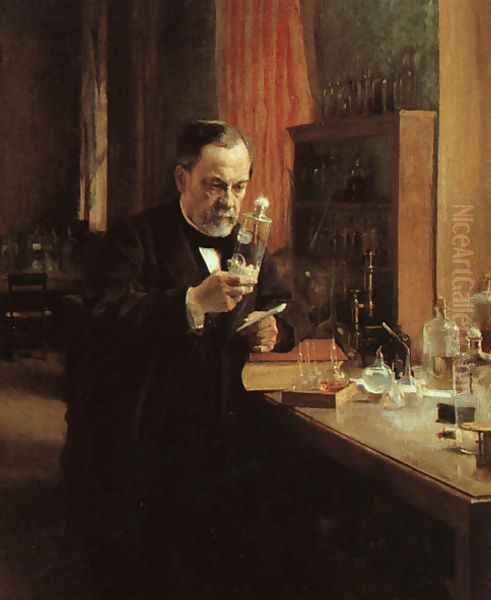
His engagement with the Parisian art world extended beyond contemporary trends. He deeply admired the Spanish masters, particularly Diego Velázquez and Francisco Goya, whose works he studied in the Louvre. Their mastery of realism, psychological depth, and bold brushwork resonated with his own artistic goals. A five-week trip to Spain further immersed him in the country's art and culture, reinforcing the influence of Spanish painting and the contemporary trend of French Hispanicism on his work.
Masterpieces of Portraiture: The Pasteur Portrait
Edelfelt excelled in portraiture, demonstrating a remarkable ability to capture not only the physical likeness but also the personality and inner life of his sitters. His most famous work in this genre, and arguably his most celebrated painting overall, is the Portrait of Louis Pasteur (1885). Commissioned during Pasteur's peak fame, the portrait depicts the renowned scientist in his laboratory, holding a vial, surrounded by scientific apparatus.
To create this iconic image, Edelfelt spent considerable time observing Pasteur at work, meticulously studying the laboratory environment and seeking to understand the man behind the scientific legend. The resulting portrait is a triumph of realistic depiction and psychological insight, conveying Pasteur's dedication, intellect, and humanity. Pasteur himself was reportedly delighted with the portrait, praising Edelfelt's ability to capture his essence. The painting was exhibited at the Paris Salon of 1886, where it received critical acclaim and earned Edelfelt the prestigious Legion of Honour, cementing his international reputation.
Depicting Finnish Life and Landscape
Despite his success and long periods spent in Paris, Edelfelt remained deeply connected to his homeland. He spent his summers in Finland, particularly at Haikko Manor near Porvoo, where he maintained a studio. These Finnish summers provided the inspiration for many of his most beloved works, which captured the landscapes and people of Finland with sensitivity and affection.
Works like Boys Playing on the Shore (1884) and Women of Ruokolahti on the Church Hill (1887) exemplify his skill in depicting Finnish rural life. He rendered the clear northern light, the tranquil waters, and the figures of ordinary Finns with a naturalism that felt both authentic and poetic. These paintings played a significant role in shaping the visual identity of Finland during a period of growing national consciousness under Russian rule. They presented an image of Finnish culture and resilience to both domestic and international audiences.
Another notable work reflecting his engagement with contemporary life and perhaps his Parisian experiences is The Luxembourg Gardens, Paris (1887). This painting showcases his mastery of capturing the fleeting effects of light and the atmosphere of urban leisure, demonstrating his absorption of Impressionist influences while retaining his characteristic clarity of form.
Historical Themes and National Identity
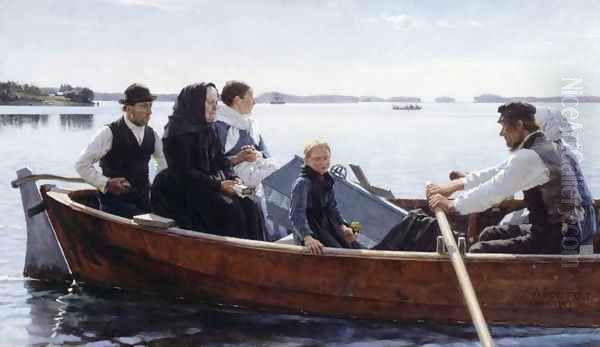
Edelfelt began his career with ambitions in history painting, a genre highly esteemed in academic circles. His early works, such as Duke Karl Insulting the Corpse of Klaus Fleming (1878), demonstrated his technical skill and dramatic flair. While he later moved towards contemporary subjects, he never entirely abandoned historical themes, particularly those relevant to Finnish history and identity.
His most significant contribution in this area later in his career came through illustration. He created powerful illustrations for Johan Ludvig Runeberg's epic poem The Tales of Ensign Stål, which narrated episodes from the Finnish War (1808-1809). These illustrations, executed with historical accuracy and patriotic fervor, became immensely popular and further solidified Edelfelt's status as a national artist. They visualized key moments of Finnish history and heroism for a wide audience. His dedication to research was evident in works like his Finnish Soldiers series, showcasing his commitment to historical authenticity.
International Recognition and Cultural Diplomacy
Edelfelt's regular participation in the Paris Salon, the most important art exhibition of the era, was crucial to his international success. His technical skill, combined with the appealing subject matter of his Finnish scenes and his insightful portraits, garnered positive reviews and prestigious awards. He became the face of Finnish art abroad, demonstrating that artists from smaller nations could compete at the highest level.
His influence extended beyond his own canvases. Edelfelt used his connections and reputation to promote Finnish art and culture internationally. He played a key role in organizing the Finnish pavilion at the Exposition Universelle (World's Fair) in Paris in 1900. Amidst increasing political pressure from Russia (the Russification policies), the Finnish pavilion was a powerful statement of Finland's distinct cultural identity, and Edelfelt's efforts were instrumental in its success. He actively mentored younger Finnish artists, such as Akseli Gallen-Kallela, Eero Järnefelt, and Helene Schjerfbeck, helping them navigate the international art scene.
Personal Life: Love, Loss, and Family
Edelfelt's personal life was marked by both joy and sorrow. In Paris, he experienced passionate relationships, including one with a model known as Virginie, whom he painted in the sensitive work Virginie (1883). Her subsequent early death cast a shadow over this period. Another significant relationship was with Antonia Bonjean.
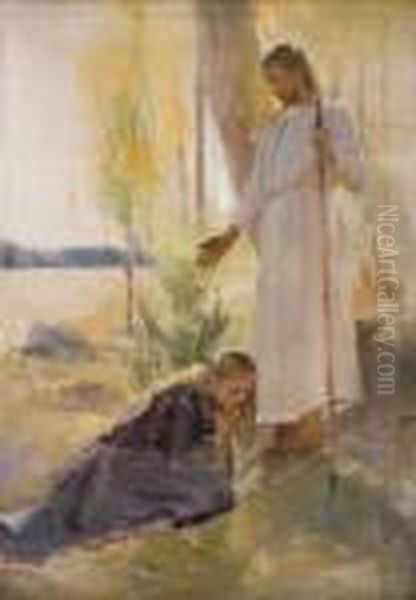
In 1888, Edelfelt married a Finnish noblewoman, Baroness Anna Elise (Ellan) de la Chapelle. The marriage produced one son, Erik, born in 1889. While the marriage provided stability, correspondence suggests the relationship between Albert and Ellan may have been somewhat reserved or complex at times. Edelfelt maintained an exceptionally close bond with his mother, Alexandra, throughout his life. He wrote to her frequently from abroad, sharing his thoughts, experiences, and artistic concerns. Her death in 1901 was a devastating blow from which he reportedly never fully recovered, contributing to a decline in his health.
Later Years, Legacy, and Influence
In his later years, Edelfelt continued to paint, dividing his time between Paris and Finland. He remained a highly respected figure in the art world, receiving commissions and honors. His style continued to evolve subtly, but he remained committed to the principles of Realism and Naturalism that had defined his mature work. His influence on subsequent generations of Finnish artists was profound; he had demonstrated that it was possible to be both distinctly Finnish and internationally relevant.
Tragically, Edelfelt's life was cut short. He died of heart failure on August 18, 1905, at Haikko Manor, aged just 51. His death was mourned throughout Finland and in the international art community. He left behind a rich legacy, not only through his impressive body of work but also through his role in elevating Finnish art and culture.
Today, Albert Edelfelt is celebrated as one of Finland's greatest painters. His works are housed in major museums in Finland, including the Ateneum Art Museum in Helsinki, and internationally. The Albert Edelfelt Studio Museum, located at Haikko Manor, preserves his summer studio and offers insight into his life and working methods. He remains a symbol of artistic excellence and national pride, a bridge between Finnish tradition and European modernity. His ability to capture light, character, and the spirit of his time ensures his enduring appeal.
Conclusion: An Enduring Vision
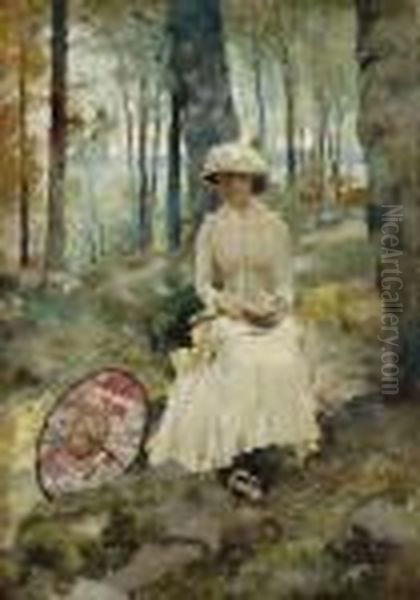
Albert Edelfelt's journey from a talented youth in Porvoo to an internationally acclaimed master in Paris is a testament to his dedication, skill, and adaptability. He navigated the complex art world of the late 19th century, absorbing academic training, embracing Realism and Naturalism, and engaging with Impressionist ideas, all while retaining a unique voice deeply rooted in his Finnish identity. His portraits reveal profound psychological depth, his landscapes capture the specific beauty of northern light, and his historical works and illustrations resonate with national sentiment. More than just a painter, Edelfelt was a pivotal figure who opened doors for Finnish art on the global stage, leaving an indelible mark on the cultural landscape of his nation and beyond. His legacy continues to inspire, reminding us of the power of art to capture truth, beauty, and the enduring human spirit.